-

Jim Schoppert (Tlingit, 1947–1992) Untitled Carved Panel, 1984 Wood, paint Signed and dated upper right panel 'Schoppert, 1984' 87 in. (length) × 30 in. (height of taller panels) Robert James “Jim” Schoppert (1947–1992) stands as one of the most influential and innovative Native American artists of the late 20th century. A member of the Tlingit people of Southeast Alaska, Schoppert’s career was marked by a fearless commitment to expanding the boundaries of Northwest Coast art. While trained in traditional carving and formline design, he refused to be confined by inherited conventions. Instead, he fused ancestral motifs with the language of modern abstraction, producing works that are both deeply rooted in tradition and boldly contemporary. The present panel up for bid, signed and dated 1984 by the artist, exemplifies Schoppert’s radical approach at the height of his career. Measuring an impressive 87 inches in length and 30 inches in height, the work commands attention with its monumental scale and color variations of blues, burgundies and purples. Its rhythmic carving and dynamic surface treatments reflect his deliberate departure from strict formline symmetry in favor of layered cuts, unexpected patterning, and the expressive use of paint. These qualities demonstrate his belief that Native art should remain a living, evolving practice rather than a static reflection of the past. As Schoppert himself wrote, “Innovation is tradition. Without change, tradition becomes a prison.” Schoppert’s carved panels occupy a critical place in his oeuvre. They represent his most ambitious explorations of scale and surface, and have been recognized as pivotal to his artistic legacy. Comparable works are held in the permanent collections of the Smithsonian Institution’s National Museum of the American Indian, the Alaska State Museum, and the Heard Museum, among others. His public commissions—including the monumental installation at Seattle’s I-90 floating bridge—further solidified his reputation as a groundbreaking artist who brought Native art visibly into contemporary civic life. This panel has remained in private hands since its acquisition in the 1980s and has never before been offered at auction. Its provenance is particularly noteworthy: it was purchased by a Mercer Island family who lived within sight of the I-90 bridge, a daily reminder of Schoppert’s artistry that deepened their admiration and inspired their collection. Carefully maintained in a non-smoking, odor-free estate, the work has been preserved in excellent condition. Works of this scale and rarity seldom appear on the market. This offering presents collectors and institutions with an exceptional opportunity to acquire an important example of Schoppert’s work—one that embodies both the power of Tlingit carving traditions and the daring innovations that secured his place in the canon of contemporary Native American art. Provenance: Acquired directly from the gallery or the artist in Seattle (although descendants cannot say which one) hung in their home on Mercer Island, Washington, 1984; thence by descent. Condition: In very nice condition overall. One small chip to the base, as shown. Estate is non-smoking and free of odors. Hooks on the back allow it to be hung on a wall easily. 1 / 13 -
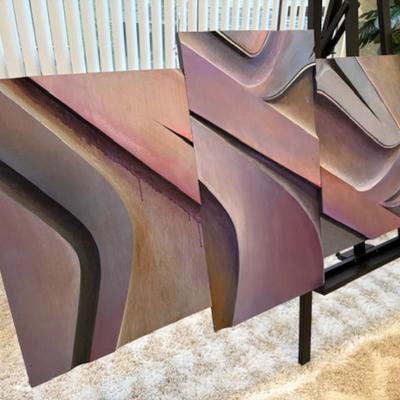
Jim Schoppert (Tlingit, 1947–1992) Untitled Carved Panel, 1984 Wood, paint Signed and dated upper right panel 'Schoppert, 1984' 87 in. (length) × 30 in. (height of taller panels) Robert James “Jim” Schoppert (1947–1992) stands as one of the most influential and innovative Native American artists of the late 20th century. A member of the Tlingit people of Southeast Alaska, Schoppert’s career was marked by a fearless commitment to expanding the boundaries of Northwest Coast art. While trained in traditional carving and formline design, he refused to be confined by inherited conventions. Instead, he fused ancestral motifs with the language of modern abstraction, producing works that are both deeply rooted in tradition and boldly contemporary. The present panel up for bid, signed and dated 1984 by the artist, exemplifies Schoppert’s radical approach at the height of his career. Measuring an impressive 87 inches in length and 30 inches in height, the work commands attention with its monumental scale and color variations of blues, burgundies and purples. Its rhythmic carving and dynamic surface treatments reflect his deliberate departure from strict formline symmetry in favor of layered cuts, unexpected patterning, and the expressive use of paint. These qualities demonstrate his belief that Native art should remain a living, evolving practice rather than a static reflection of the past. As Schoppert himself wrote, “Innovation is tradition. Without change, tradition becomes a prison.” Schoppert’s carved panels occupy a critical place in his oeuvre. They represent his most ambitious explorations of scale and surface, and have been recognized as pivotal to his artistic legacy. Comparable works are held in the permanent collections of the Smithsonian Institution’s National Museum of the American Indian, the Alaska State Museum, and the Heard Museum, among others. His public commissions—including the monumental installation at Seattle’s I-90 floating bridge—further solidified his reputation as a groundbreaking artist who brought Native art visibly into contemporary civic life. This panel has remained in private hands since its acquisition in the 1980s and has never before been offered at auction. Its provenance is particularly noteworthy: it was purchased by a Mercer Island family who lived within sight of the I-90 bridge, a daily reminder of Schoppert’s artistry that deepened their admiration and inspired their collection. Carefully maintained in a non-smoking, odor-free estate, the work has been preserved in excellent condition. Works of this scale and rarity seldom appear on the market. This offering presents collectors and institutions with an exceptional opportunity to acquire an important example of Schoppert’s work—one that embodies both the power of Tlingit carving traditions and the daring innovations that secured his place in the canon of contemporary Native American art. Provenance: Acquired directly from the gallery or the artist in Seattle (although descendants cannot say which one) hung in their home on Mercer Island, Washington, 1984; thence by descent. Condition: In very nice condition overall. One small chip to the base, as shown. Estate is non-smoking and free of odors. Hooks on the back allow it to be hung on a wall easily. 2 / 13 -
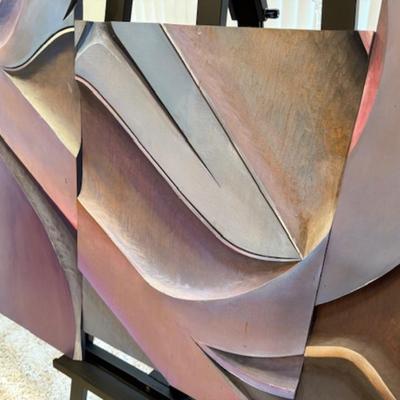
Jim Schoppert (Tlingit, 1947–1992) Untitled Carved Panel, 1984 Wood, paint Signed and dated upper right panel 'Schoppert, 1984' 87 in. (length) × 30 in. (height of taller panels) Robert James “Jim” Schoppert (1947–1992) stands as one of the most influential and innovative Native American artists of the late 20th century. A member of the Tlingit people of Southeast Alaska, Schoppert’s career was marked by a fearless commitment to expanding the boundaries of Northwest Coast art. While trained in traditional carving and formline design, he refused to be confined by inherited conventions. Instead, he fused ancestral motifs with the language of modern abstraction, producing works that are both deeply rooted in tradition and boldly contemporary. The present panel up for bid, signed and dated 1984 by the artist, exemplifies Schoppert’s radical approach at the height of his career. Measuring an impressive 87 inches in length and 30 inches in height, the work commands attention with its monumental scale and color variations of blues, burgundies and purples. Its rhythmic carving and dynamic surface treatments reflect his deliberate departure from strict formline symmetry in favor of layered cuts, unexpected patterning, and the expressive use of paint. These qualities demonstrate his belief that Native art should remain a living, evolving practice rather than a static reflection of the past. As Schoppert himself wrote, “Innovation is tradition. Without change, tradition becomes a prison.” Schoppert’s carved panels occupy a critical place in his oeuvre. They represent his most ambitious explorations of scale and surface, and have been recognized as pivotal to his artistic legacy. Comparable works are held in the permanent collections of the Smithsonian Institution’s National Museum of the American Indian, the Alaska State Museum, and the Heard Museum, among others. His public commissions—including the monumental installation at Seattle’s I-90 floating bridge—further solidified his reputation as a groundbreaking artist who brought Native art visibly into contemporary civic life. This panel has remained in private hands since its acquisition in the 1980s and has never before been offered at auction. Its provenance is particularly noteworthy: it was purchased by a Mercer Island family who lived within sight of the I-90 bridge, a daily reminder of Schoppert’s artistry that deepened their admiration and inspired their collection. Carefully maintained in a non-smoking, odor-free estate, the work has been preserved in excellent condition. Works of this scale and rarity seldom appear on the market. This offering presents collectors and institutions with an exceptional opportunity to acquire an important example of Schoppert’s work—one that embodies both the power of Tlingit carving traditions and the daring innovations that secured his place in the canon of contemporary Native American art. Provenance: Acquired directly from the gallery or the artist in Seattle (although descendants cannot say which one) hung in their home on Mercer Island, Washington, 1984; thence by descent. Condition: In very nice condition overall. One small chip to the base, as shown. Estate is non-smoking and free of odors. Hooks on the back allow it to be hung on a wall easily. 3 / 13 -
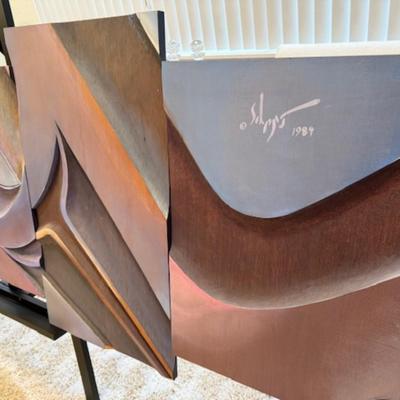
Jim Schoppert (Tlingit, 1947–1992) Untitled Carved Panel, 1984 Wood, paint Signed and dated upper right panel 'Schoppert, 1984' 87 in. (length) × 30 in. (height of taller panels) Robert James “Jim” Schoppert (1947–1992) stands as one of the most influential and innovative Native American artists of the late 20th century. A member of the Tlingit people of Southeast Alaska, Schoppert’s career was marked by a fearless commitment to expanding the boundaries of Northwest Coast art. While trained in traditional carving and formline design, he refused to be confined by inherited conventions. Instead, he fused ancestral motifs with the language of modern abstraction, producing works that are both deeply rooted in tradition and boldly contemporary. The present panel up for bid, signed and dated 1984 by the artist, exemplifies Schoppert’s radical approach at the height of his career. Measuring an impressive 87 inches in length and 30 inches in height, the work commands attention with its monumental scale and color variations of blues, burgundies and purples. Its rhythmic carving and dynamic surface treatments reflect his deliberate departure from strict formline symmetry in favor of layered cuts, unexpected patterning, and the expressive use of paint. These qualities demonstrate his belief that Native art should remain a living, evolving practice rather than a static reflection of the past. As Schoppert himself wrote, “Innovation is tradition. Without change, tradition becomes a prison.” Schoppert’s carved panels occupy a critical place in his oeuvre. They represent his most ambitious explorations of scale and surface, and have been recognized as pivotal to his artistic legacy. Comparable works are held in the permanent collections of the Smithsonian Institution’s National Museum of the American Indian, the Alaska State Museum, and the Heard Museum, among others. His public commissions—including the monumental installation at Seattle’s I-90 floating bridge—further solidified his reputation as a groundbreaking artist who brought Native art visibly into contemporary civic life. This panel has remained in private hands since its acquisition in the 1980s and has never before been offered at auction. Its provenance is particularly noteworthy: it was purchased by a Mercer Island family who lived within sight of the I-90 bridge, a daily reminder of Schoppert’s artistry that deepened their admiration and inspired their collection. Carefully maintained in a non-smoking, odor-free estate, the work has been preserved in excellent condition. Works of this scale and rarity seldom appear on the market. This offering presents collectors and institutions with an exceptional opportunity to acquire an important example of Schoppert’s work—one that embodies both the power of Tlingit carving traditions and the daring innovations that secured his place in the canon of contemporary Native American art. Provenance: Acquired directly from the gallery or the artist in Seattle (although descendants cannot say which one) hung in their home on Mercer Island, Washington, 1984; thence by descent. Condition: In very nice condition overall. One small chip to the base, as shown. Estate is non-smoking and free of odors. Hooks on the back allow it to be hung on a wall easily. 4 / 13 -
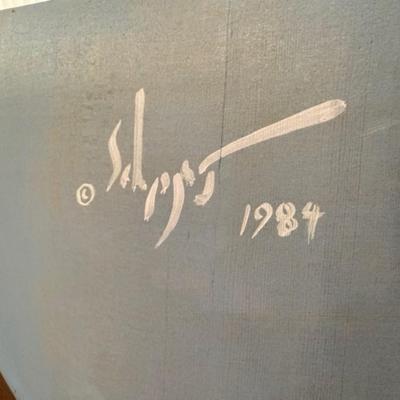
Jim Schoppert (Tlingit, 1947–1992) Untitled Carved Panel, 1984 Wood, paint Signed and dated upper right panel 'Schoppert, 1984' 87 in. (length) × 30 in. (height of taller panels) Robert James “Jim” Schoppert (1947–1992) stands as one of the most influential and innovative Native American artists of the late 20th century. A member of the Tlingit people of Southeast Alaska, Schoppert’s career was marked by a fearless commitment to expanding the boundaries of Northwest Coast art. While trained in traditional carving and formline design, he refused to be confined by inherited conventions. Instead, he fused ancestral motifs with the language of modern abstraction, producing works that are both deeply rooted in tradition and boldly contemporary. The present panel up for bid, signed and dated 1984 by the artist, exemplifies Schoppert’s radical approach at the height of his career. Measuring an impressive 87 inches in length and 30 inches in height, the work commands attention with its monumental scale and color variations of blues, burgundies and purples. Its rhythmic carving and dynamic surface treatments reflect his deliberate departure from strict formline symmetry in favor of layered cuts, unexpected patterning, and the expressive use of paint. These qualities demonstrate his belief that Native art should remain a living, evolving practice rather than a static reflection of the past. As Schoppert himself wrote, “Innovation is tradition. Without change, tradition becomes a prison.” Schoppert’s carved panels occupy a critical place in his oeuvre. They represent his most ambitious explorations of scale and surface, and have been recognized as pivotal to his artistic legacy. Comparable works are held in the permanent collections of the Smithsonian Institution’s National Museum of the American Indian, the Alaska State Museum, and the Heard Museum, among others. His public commissions—including the monumental installation at Seattle’s I-90 floating bridge—further solidified his reputation as a groundbreaking artist who brought Native art visibly into contemporary civic life. This panel has remained in private hands since its acquisition in the 1980s and has never before been offered at auction. Its provenance is particularly noteworthy: it was purchased by a Mercer Island family who lived within sight of the I-90 bridge, a daily reminder of Schoppert’s artistry that deepened their admiration and inspired their collection. Carefully maintained in a non-smoking, odor-free estate, the work has been preserved in excellent condition. Works of this scale and rarity seldom appear on the market. This offering presents collectors and institutions with an exceptional opportunity to acquire an important example of Schoppert’s work—one that embodies both the power of Tlingit carving traditions and the daring innovations that secured his place in the canon of contemporary Native American art. Provenance: Acquired directly from the gallery or the artist in Seattle (although descendants cannot say which one) hung in their home on Mercer Island, Washington, 1984; thence by descent. Condition: In very nice condition overall. One small chip to the base, as shown. Estate is non-smoking and free of odors. Hooks on the back allow it to be hung on a wall easily. 5 / 13 -
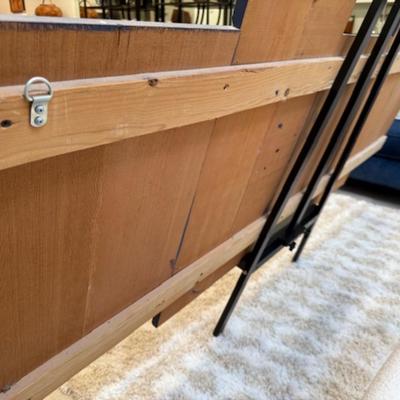
Jim Schoppert (Tlingit, 1947–1992) Untitled Carved Panel, 1984 Wood, paint Signed and dated upper right panel 'Schoppert, 1984' 87 in. (length) × 30 in. (height of taller panels) Robert James “Jim” Schoppert (1947–1992) stands as one of the most influential and innovative Native American artists of the late 20th century. A member of the Tlingit people of Southeast Alaska, Schoppert’s career was marked by a fearless commitment to expanding the boundaries of Northwest Coast art. While trained in traditional carving and formline design, he refused to be confined by inherited conventions. Instead, he fused ancestral motifs with the language of modern abstraction, producing works that are both deeply rooted in tradition and boldly contemporary. The present panel up for bid, signed and dated 1984 by the artist, exemplifies Schoppert’s radical approach at the height of his career. Measuring an impressive 87 inches in length and 30 inches in height, the work commands attention with its monumental scale and color variations of blues, burgundies and purples. Its rhythmic carving and dynamic surface treatments reflect his deliberate departure from strict formline symmetry in favor of layered cuts, unexpected patterning, and the expressive use of paint. These qualities demonstrate his belief that Native art should remain a living, evolving practice rather than a static reflection of the past. As Schoppert himself wrote, “Innovation is tradition. Without change, tradition becomes a prison.” Schoppert’s carved panels occupy a critical place in his oeuvre. They represent his most ambitious explorations of scale and surface, and have been recognized as pivotal to his artistic legacy. Comparable works are held in the permanent collections of the Smithsonian Institution’s National Museum of the American Indian, the Alaska State Museum, and the Heard Museum, among others. His public commissions—including the monumental installation at Seattle’s I-90 floating bridge—further solidified his reputation as a groundbreaking artist who brought Native art visibly into contemporary civic life. This panel has remained in private hands since its acquisition in the 1980s and has never before been offered at auction. Its provenance is particularly noteworthy: it was purchased by a Mercer Island family who lived within sight of the I-90 bridge, a daily reminder of Schoppert’s artistry that deepened their admiration and inspired their collection. Carefully maintained in a non-smoking, odor-free estate, the work has been preserved in excellent condition. Works of this scale and rarity seldom appear on the market. This offering presents collectors and institutions with an exceptional opportunity to acquire an important example of Schoppert’s work—one that embodies both the power of Tlingit carving traditions and the daring innovations that secured his place in the canon of contemporary Native American art. Provenance: Acquired directly from the gallery or the artist in Seattle (although descendants cannot say which one) hung in their home on Mercer Island, Washington, 1984; thence by descent. Condition: In very nice condition overall. One small chip to the base, as shown. Estate is non-smoking and free of odors. Hooks on the back allow it to be hung on a wall easily. 6 / 13 -
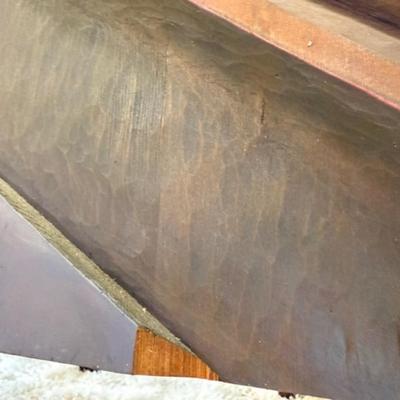
Jim Schoppert (Tlingit, 1947–1992) Untitled Carved Panel, 1984 Wood, paint Signed and dated upper right panel 'Schoppert, 1984' 87 in. (length) × 30 in. (height of taller panels) Robert James “Jim” Schoppert (1947–1992) stands as one of the most influential and innovative Native American artists of the late 20th century. A member of the Tlingit people of Southeast Alaska, Schoppert’s career was marked by a fearless commitment to expanding the boundaries of Northwest Coast art. While trained in traditional carving and formline design, he refused to be confined by inherited conventions. Instead, he fused ancestral motifs with the language of modern abstraction, producing works that are both deeply rooted in tradition and boldly contemporary. The present panel up for bid, signed and dated 1984 by the artist, exemplifies Schoppert’s radical approach at the height of his career. Measuring an impressive 87 inches in length and 30 inches in height, the work commands attention with its monumental scale and color variations of blues, burgundies and purples. Its rhythmic carving and dynamic surface treatments reflect his deliberate departure from strict formline symmetry in favor of layered cuts, unexpected patterning, and the expressive use of paint. These qualities demonstrate his belief that Native art should remain a living, evolving practice rather than a static reflection of the past. As Schoppert himself wrote, “Innovation is tradition. Without change, tradition becomes a prison.” Schoppert’s carved panels occupy a critical place in his oeuvre. They represent his most ambitious explorations of scale and surface, and have been recognized as pivotal to his artistic legacy. Comparable works are held in the permanent collections of the Smithsonian Institution’s National Museum of the American Indian, the Alaska State Museum, and the Heard Museum, among others. His public commissions—including the monumental installation at Seattle’s I-90 floating bridge—further solidified his reputation as a groundbreaking artist who brought Native art visibly into contemporary civic life. This panel has remained in private hands since its acquisition in the 1980s and has never before been offered at auction. Its provenance is particularly noteworthy: it was purchased by a Mercer Island family who lived within sight of the I-90 bridge, a daily reminder of Schoppert’s artistry that deepened their admiration and inspired their collection. Carefully maintained in a non-smoking, odor-free estate, the work has been preserved in excellent condition. Works of this scale and rarity seldom appear on the market. This offering presents collectors and institutions with an exceptional opportunity to acquire an important example of Schoppert’s work—one that embodies both the power of Tlingit carving traditions and the daring innovations that secured his place in the canon of contemporary Native American art. Provenance: Acquired directly from the gallery or the artist in Seattle (although descendants cannot say which one) hung in their home on Mercer Island, Washington, 1984; thence by descent. Condition: In very nice condition overall. One small chip to the base, as shown. Estate is non-smoking and free of odors. Hooks on the back allow it to be hung on a wall easily. 7 / 13 -
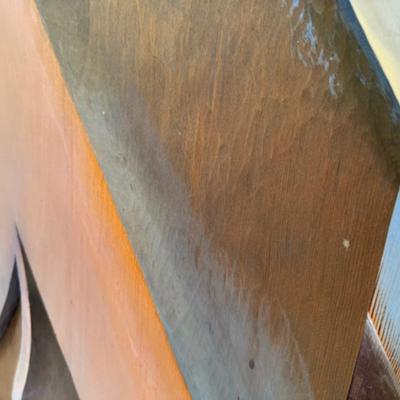
Jim Schoppert (Tlingit, 1947–1992) Untitled Carved Panel, 1984 Wood, paint Signed and dated upper right panel 'Schoppert, 1984' 87 in. (length) × 30 in. (height of taller panels) Robert James “Jim” Schoppert (1947–1992) stands as one of the most influential and innovative Native American artists of the late 20th century. A member of the Tlingit people of Southeast Alaska, Schoppert’s career was marked by a fearless commitment to expanding the boundaries of Northwest Coast art. While trained in traditional carving and formline design, he refused to be confined by inherited conventions. Instead, he fused ancestral motifs with the language of modern abstraction, producing works that are both deeply rooted in tradition and boldly contemporary. The present panel up for bid, signed and dated 1984 by the artist, exemplifies Schoppert’s radical approach at the height of his career. Measuring an impressive 87 inches in length and 30 inches in height, the work commands attention with its monumental scale and color variations of blues, burgundies and purples. Its rhythmic carving and dynamic surface treatments reflect his deliberate departure from strict formline symmetry in favor of layered cuts, unexpected patterning, and the expressive use of paint. These qualities demonstrate his belief that Native art should remain a living, evolving practice rather than a static reflection of the past. As Schoppert himself wrote, “Innovation is tradition. Without change, tradition becomes a prison.” Schoppert’s carved panels occupy a critical place in his oeuvre. They represent his most ambitious explorations of scale and surface, and have been recognized as pivotal to his artistic legacy. Comparable works are held in the permanent collections of the Smithsonian Institution’s National Museum of the American Indian, the Alaska State Museum, and the Heard Museum, among others. His public commissions—including the monumental installation at Seattle’s I-90 floating bridge—further solidified his reputation as a groundbreaking artist who brought Native art visibly into contemporary civic life. This panel has remained in private hands since its acquisition in the 1980s and has never before been offered at auction. Its provenance is particularly noteworthy: it was purchased by a Mercer Island family who lived within sight of the I-90 bridge, a daily reminder of Schoppert’s artistry that deepened their admiration and inspired their collection. Carefully maintained in a non-smoking, odor-free estate, the work has been preserved in excellent condition. Works of this scale and rarity seldom appear on the market. This offering presents collectors and institutions with an exceptional opportunity to acquire an important example of Schoppert’s work—one that embodies both the power of Tlingit carving traditions and the daring innovations that secured his place in the canon of contemporary Native American art. Provenance: Acquired directly from the gallery or the artist in Seattle (although descendants cannot say which one) hung in their home on Mercer Island, Washington, 1984; thence by descent. Condition: In very nice condition overall. One small chip to the base, as shown. Estate is non-smoking and free of odors. Hooks on the back allow it to be hung on a wall easily. 8 / 13 -
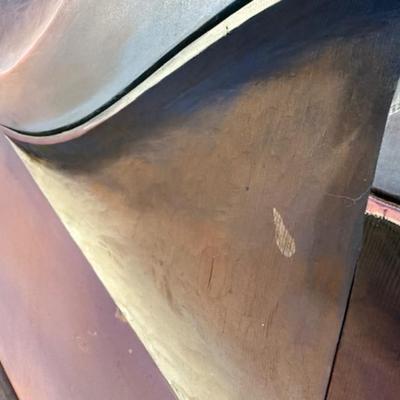
Jim Schoppert (Tlingit, 1947–1992) Untitled Carved Panel, 1984 Wood, paint Signed and dated upper right panel 'Schoppert, 1984' 87 in. (length) × 30 in. (height of taller panels) Robert James “Jim” Schoppert (1947–1992) stands as one of the most influential and innovative Native American artists of the late 20th century. A member of the Tlingit people of Southeast Alaska, Schoppert’s career was marked by a fearless commitment to expanding the boundaries of Northwest Coast art. While trained in traditional carving and formline design, he refused to be confined by inherited conventions. Instead, he fused ancestral motifs with the language of modern abstraction, producing works that are both deeply rooted in tradition and boldly contemporary. The present panel up for bid, signed and dated 1984 by the artist, exemplifies Schoppert’s radical approach at the height of his career. Measuring an impressive 87 inches in length and 30 inches in height, the work commands attention with its monumental scale and color variations of blues, burgundies and purples. Its rhythmic carving and dynamic surface treatments reflect his deliberate departure from strict formline symmetry in favor of layered cuts, unexpected patterning, and the expressive use of paint. These qualities demonstrate his belief that Native art should remain a living, evolving practice rather than a static reflection of the past. As Schoppert himself wrote, “Innovation is tradition. Without change, tradition becomes a prison.” Schoppert’s carved panels occupy a critical place in his oeuvre. They represent his most ambitious explorations of scale and surface, and have been recognized as pivotal to his artistic legacy. Comparable works are held in the permanent collections of the Smithsonian Institution’s National Museum of the American Indian, the Alaska State Museum, and the Heard Museum, among others. His public commissions—including the monumental installation at Seattle’s I-90 floating bridge—further solidified his reputation as a groundbreaking artist who brought Native art visibly into contemporary civic life. This panel has remained in private hands since its acquisition in the 1980s and has never before been offered at auction. Its provenance is particularly noteworthy: it was purchased by a Mercer Island family who lived within sight of the I-90 bridge, a daily reminder of Schoppert’s artistry that deepened their admiration and inspired their collection. Carefully maintained in a non-smoking, odor-free estate, the work has been preserved in excellent condition. Works of this scale and rarity seldom appear on the market. This offering presents collectors and institutions with an exceptional opportunity to acquire an important example of Schoppert’s work—one that embodies both the power of Tlingit carving traditions and the daring innovations that secured his place in the canon of contemporary Native American art. Provenance: Acquired directly from the gallery or the artist in Seattle (although descendants cannot say which one) hung in their home on Mercer Island, Washington, 1984; thence by descent. Condition: In very nice condition overall. One small chip to the base, as shown. Estate is non-smoking and free of odors. Hooks on the back allow it to be hung on a wall easily. 9 / 13 -
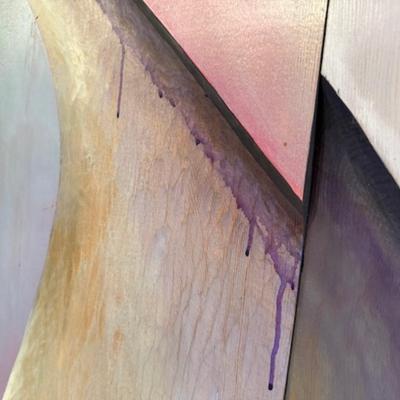
Jim Schoppert (Tlingit, 1947–1992) Untitled Carved Panel, 1984 Wood, paint Signed and dated upper right panel 'Schoppert, 1984' 87 in. (length) × 30 in. (height of taller panels) Robert James “Jim” Schoppert (1947–1992) stands as one of the most influential and innovative Native American artists of the late 20th century. A member of the Tlingit people of Southeast Alaska, Schoppert’s career was marked by a fearless commitment to expanding the boundaries of Northwest Coast art. While trained in traditional carving and formline design, he refused to be confined by inherited conventions. Instead, he fused ancestral motifs with the language of modern abstraction, producing works that are both deeply rooted in tradition and boldly contemporary. The present panel up for bid, signed and dated 1984 by the artist, exemplifies Schoppert’s radical approach at the height of his career. Measuring an impressive 87 inches in length and 30 inches in height, the work commands attention with its monumental scale and color variations of blues, burgundies and purples. Its rhythmic carving and dynamic surface treatments reflect his deliberate departure from strict formline symmetry in favor of layered cuts, unexpected patterning, and the expressive use of paint. These qualities demonstrate his belief that Native art should remain a living, evolving practice rather than a static reflection of the past. As Schoppert himself wrote, “Innovation is tradition. Without change, tradition becomes a prison.” Schoppert’s carved panels occupy a critical place in his oeuvre. They represent his most ambitious explorations of scale and surface, and have been recognized as pivotal to his artistic legacy. Comparable works are held in the permanent collections of the Smithsonian Institution’s National Museum of the American Indian, the Alaska State Museum, and the Heard Museum, among others. His public commissions—including the monumental installation at Seattle’s I-90 floating bridge—further solidified his reputation as a groundbreaking artist who brought Native art visibly into contemporary civic life. This panel has remained in private hands since its acquisition in the 1980s and has never before been offered at auction. Its provenance is particularly noteworthy: it was purchased by a Mercer Island family who lived within sight of the I-90 bridge, a daily reminder of Schoppert’s artistry that deepened their admiration and inspired their collection. Carefully maintained in a non-smoking, odor-free estate, the work has been preserved in excellent condition. Works of this scale and rarity seldom appear on the market. This offering presents collectors and institutions with an exceptional opportunity to acquire an important example of Schoppert’s work—one that embodies both the power of Tlingit carving traditions and the daring innovations that secured his place in the canon of contemporary Native American art. Provenance: Acquired directly from the gallery or the artist in Seattle (although descendants cannot say which one) hung in their home on Mercer Island, Washington, 1984; thence by descent. Condition: In very nice condition overall. One small chip to the base, as shown. Estate is non-smoking and free of odors. Hooks on the back allow it to be hung on a wall easily. 10 / 13 -
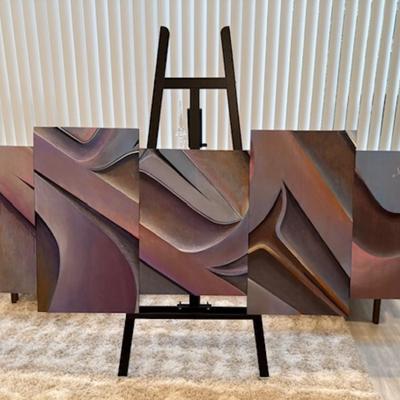
Jim Schoppert (Tlingit, 1947–1992) Untitled Carved Panel, 1984 Wood, paint Signed and dated upper right panel 'Schoppert, 1984' 87 in. (length) × 30 in. (height of taller panels) Robert James “Jim” Schoppert (1947–1992) stands as one of the most influential and innovative Native American artists of the late 20th century. A member of the Tlingit people of Southeast Alaska, Schoppert’s career was marked by a fearless commitment to expanding the boundaries of Northwest Coast art. While trained in traditional carving and formline design, he refused to be confined by inherited conventions. Instead, he fused ancestral motifs with the language of modern abstraction, producing works that are both deeply rooted in tradition and boldly contemporary. The present panel up for bid, signed and dated 1984 by the artist, exemplifies Schoppert’s radical approach at the height of his career. Measuring an impressive 87 inches in length and 30 inches in height, the work commands attention with its monumental scale and color variations of blues, burgundies and purples. Its rhythmic carving and dynamic surface treatments reflect his deliberate departure from strict formline symmetry in favor of layered cuts, unexpected patterning, and the expressive use of paint. These qualities demonstrate his belief that Native art should remain a living, evolving practice rather than a static reflection of the past. As Schoppert himself wrote, “Innovation is tradition. Without change, tradition becomes a prison.” Schoppert’s carved panels occupy a critical place in his oeuvre. They represent his most ambitious explorations of scale and surface, and have been recognized as pivotal to his artistic legacy. Comparable works are held in the permanent collections of the Smithsonian Institution’s National Museum of the American Indian, the Alaska State Museum, and the Heard Museum, among others. His public commissions—including the monumental installation at Seattle’s I-90 floating bridge—further solidified his reputation as a groundbreaking artist who brought Native art visibly into contemporary civic life. This panel has remained in private hands since its acquisition in the 1980s and has never before been offered at auction. Its provenance is particularly noteworthy: it was purchased by a Mercer Island family who lived within sight of the I-90 bridge, a daily reminder of Schoppert’s artistry that deepened their admiration and inspired their collection. Carefully maintained in a non-smoking, odor-free estate, the work has been preserved in excellent condition. Works of this scale and rarity seldom appear on the market. This offering presents collectors and institutions with an exceptional opportunity to acquire an important example of Schoppert’s work—one that embodies both the power of Tlingit carving traditions and the daring innovations that secured his place in the canon of contemporary Native American art. Provenance: Acquired directly from the gallery or the artist in Seattle (although descendants cannot say which one) hung in their home on Mercer Island, Washington, 1984; thence by descent. Condition: In very nice condition overall. One small chip to the base, as shown. Estate is non-smoking and free of odors. Hooks on the back allow it to be hung on a wall easily. 11 / 13 -
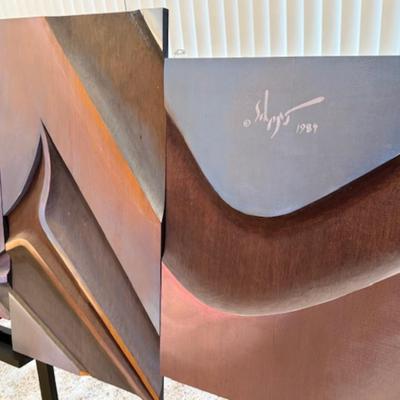
Jim Schoppert (Tlingit, 1947–1992) Untitled Carved Panel, 1984 Wood, paint Signed and dated upper right panel 'Schoppert, 1984' 87 in. (length) × 30 in. (height of taller panels) Robert James “Jim” Schoppert (1947–1992) stands as one of the most influential and innovative Native American artists of the late 20th century. A member of the Tlingit people of Southeast Alaska, Schoppert’s career was marked by a fearless commitment to expanding the boundaries of Northwest Coast art. While trained in traditional carving and formline design, he refused to be confined by inherited conventions. Instead, he fused ancestral motifs with the language of modern abstraction, producing works that are both deeply rooted in tradition and boldly contemporary. The present panel up for bid, signed and dated 1984 by the artist, exemplifies Schoppert’s radical approach at the height of his career. Measuring an impressive 87 inches in length and 30 inches in height, the work commands attention with its monumental scale and color variations of blues, burgundies and purples. Its rhythmic carving and dynamic surface treatments reflect his deliberate departure from strict formline symmetry in favor of layered cuts, unexpected patterning, and the expressive use of paint. These qualities demonstrate his belief that Native art should remain a living, evolving practice rather than a static reflection of the past. As Schoppert himself wrote, “Innovation is tradition. Without change, tradition becomes a prison.” Schoppert’s carved panels occupy a critical place in his oeuvre. They represent his most ambitious explorations of scale and surface, and have been recognized as pivotal to his artistic legacy. Comparable works are held in the permanent collections of the Smithsonian Institution’s National Museum of the American Indian, the Alaska State Museum, and the Heard Museum, among others. His public commissions—including the monumental installation at Seattle’s I-90 floating bridge—further solidified his reputation as a groundbreaking artist who brought Native art visibly into contemporary civic life. This panel has remained in private hands since its acquisition in the 1980s and has never before been offered at auction. Its provenance is particularly noteworthy: it was purchased by a Mercer Island family who lived within sight of the I-90 bridge, a daily reminder of Schoppert’s artistry that deepened their admiration and inspired their collection. Carefully maintained in a non-smoking, odor-free estate, the work has been preserved in excellent condition. Works of this scale and rarity seldom appear on the market. This offering presents collectors and institutions with an exceptional opportunity to acquire an important example of Schoppert’s work—one that embodies both the power of Tlingit carving traditions and the daring innovations that secured his place in the canon of contemporary Native American art. Provenance: Acquired directly from the gallery or the artist in Seattle (although descendants cannot say which one) hung in their home on Mercer Island, Washington, 1984; thence by descent. Condition: In very nice condition overall. One small chip to the base, as shown. Estate is non-smoking and free of odors. Hooks on the back allow it to be hung on a wall easily. 12 / 13 -
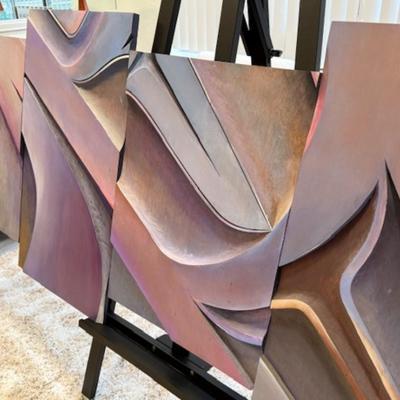
Jim Schoppert (Tlingit, 1947–1992) Untitled Carved Panel, 1984 Wood, paint Signed and dated upper right panel 'Schoppert, 1984' 87 in. (length) × 30 in. (height of taller panels) Robert James “Jim” Schoppert (1947–1992) stands as one of the most influential and innovative Native American artists of the late 20th century. A member of the Tlingit people of Southeast Alaska, Schoppert’s career was marked by a fearless commitment to expanding the boundaries of Northwest Coast art. While trained in traditional carving and formline design, he refused to be confined by inherited conventions. Instead, he fused ancestral motifs with the language of modern abstraction, producing works that are both deeply rooted in tradition and boldly contemporary. The present panel up for bid, signed and dated 1984 by the artist, exemplifies Schoppert’s radical approach at the height of his career. Measuring an impressive 87 inches in length and 30 inches in height, the work commands attention with its monumental scale and color variations of blues, burgundies and purples. Its rhythmic carving and dynamic surface treatments reflect his deliberate departure from strict formline symmetry in favor of layered cuts, unexpected patterning, and the expressive use of paint. These qualities demonstrate his belief that Native art should remain a living, evolving practice rather than a static reflection of the past. As Schoppert himself wrote, “Innovation is tradition. Without change, tradition becomes a prison.” Schoppert’s carved panels occupy a critical place in his oeuvre. They represent his most ambitious explorations of scale and surface, and have been recognized as pivotal to his artistic legacy. Comparable works are held in the permanent collections of the Smithsonian Institution’s National Museum of the American Indian, the Alaska State Museum, and the Heard Museum, among others. His public commissions—including the monumental installation at Seattle’s I-90 floating bridge—further solidified his reputation as a groundbreaking artist who brought Native art visibly into contemporary civic life. This panel has remained in private hands since its acquisition in the 1980s and has never before been offered at auction. Its provenance is particularly noteworthy: it was purchased by a Mercer Island family who lived within sight of the I-90 bridge, a daily reminder of Schoppert’s artistry that deepened their admiration and inspired their collection. Carefully maintained in a non-smoking, odor-free estate, the work has been preserved in excellent condition. Works of this scale and rarity seldom appear on the market. This offering presents collectors and institutions with an exceptional opportunity to acquire an important example of Schoppert’s work—one that embodies both the power of Tlingit carving traditions and the daring innovations that secured his place in the canon of contemporary Native American art. Provenance: Acquired directly from the gallery or the artist in Seattle (although descendants cannot say which one) hung in their home on Mercer Island, Washington, 1984; thence by descent. Condition: In very nice condition overall. One small chip to the base, as shown. Estate is non-smoking and free of odors. Hooks on the back allow it to be hung on a wall easily. 13 / 13
Photos 1 - 13 of 13
Per page: